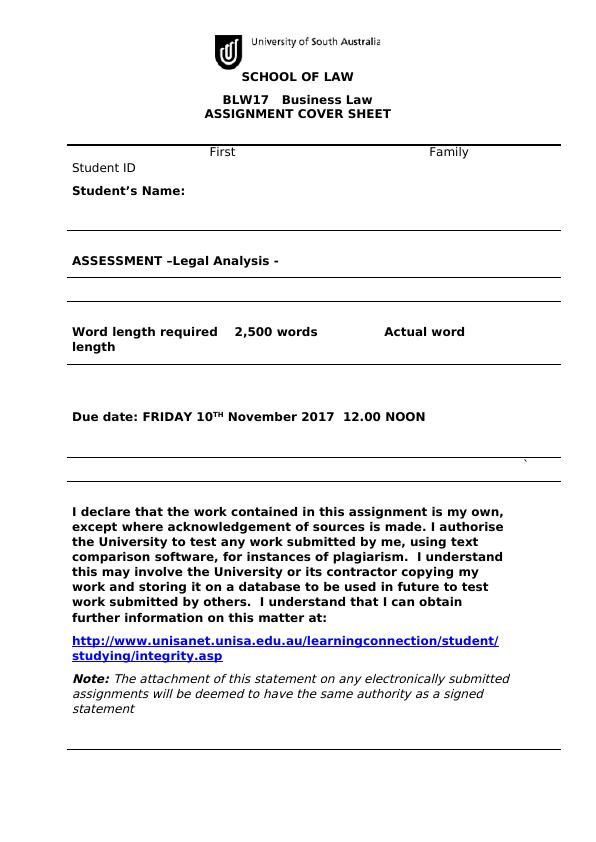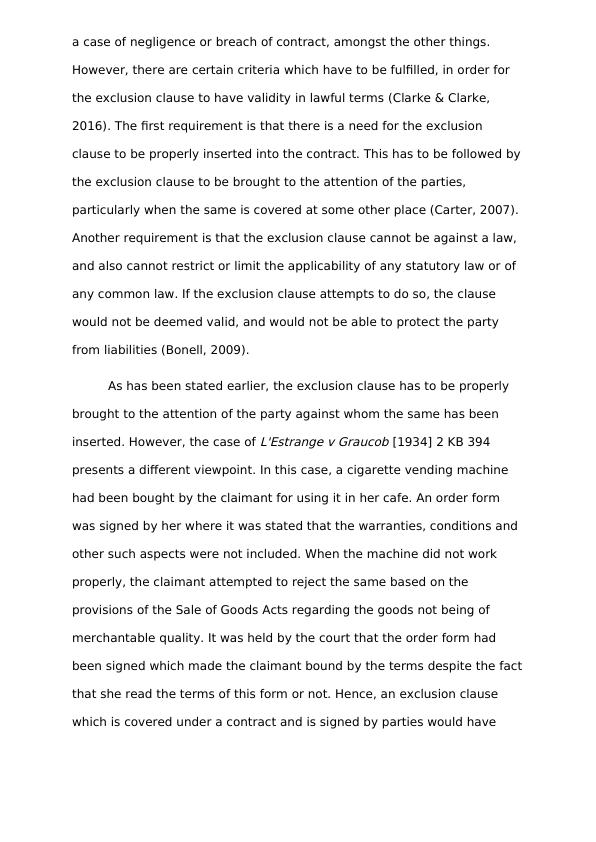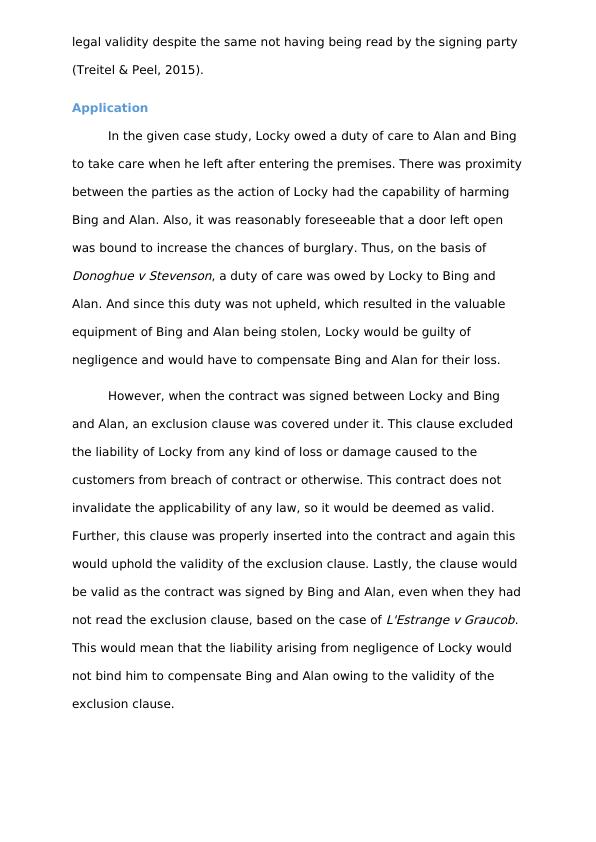BLW17 Business Law Assignment: Doc
15 Pages3783 Words34 Views
Added on 2020-05-04
BLW17 Business Law Assignment: Doc
Added on 2020-05-04
ShareRelated Documents
SCHOOL OF LAW
BLW17 Business Law
ASSIGNMENT COVER SHEET
First Family
Student ID
Student’s Name:
ASSESSMENT –Legal Analysis -
Word length required 2,500 words Actual word
length
Due date: FRIDAY 10TH November 2017 12.00 NOON
`
I declare that the work contained in this assignment is my own,
except where acknowledgement of sources is made. I authorise
the University to test any work submitted by me, using text
comparison software, for instances of plagiarism. I understand
this may involve the University or its contractor copying my
work and storing it on a database to be used in future to test
work submitted by others. I understand that I can obtain
further information on this matter at:
http://www.unisanet.unisa.edu.au/learningconnection/student/
studying/integrity.aspNote: The attachment of this statement on any electronically submitted
assignments will be deemed to have the same authority as a signed
statement
BLW17 Business Law
ASSIGNMENT COVER SHEET
First Family
Student ID
Student’s Name:
ASSESSMENT –Legal Analysis -
Word length required 2,500 words Actual word
length
Due date: FRIDAY 10TH November 2017 12.00 NOON
`
I declare that the work contained in this assignment is my own,
except where acknowledgement of sources is made. I authorise
the University to test any work submitted by me, using text
comparison software, for instances of plagiarism. I understand
this may involve the University or its contractor copying my
work and storing it on a database to be used in future to test
work submitted by others. I understand that I can obtain
further information on this matter at:
http://www.unisanet.unisa.edu.au/learningconnection/student/
studying/integrity.aspNote: The attachment of this statement on any electronically submitted
assignments will be deemed to have the same authority as a signed
statement

Signed: Date:
Type your answers here (Use minimum 11 point font and double
line OR 1.5 line spacing)
Question 1
Issue
Whether the exclusion clause inserted in the contract would give
rise to liability for Locky under negligence, or not?
Rule
A case of negligence can be made by one party, against another,
when the first party carries on such work, which has the capacity or
probability of resulting in harm for the other party, and as a result of this a
duty of care is owed. When this duty of care is breached, the case of
negligence can be made (Turner, 2013).
Donoghue v Stevenson [1932]
UKHL 100 was a case where the court held that the manufacturer of a
product owes a duty of care to consumers owing to the reasonable
foreseeability and proximity between the parties (Latimer, 2012). Where
the duty of care is not fulfilled, and there is a contravention of the same, a
case made for negligence results in the plaintiff being awarded with
damages for their loss or harm (Greene, 2013).
When a contract is formed, there are different clauses, and terms
and conditions included in it. Exclusion clause is one of the clauses in a
contract, through which one of the contracting parties is able to restrict or
limit their liability in situation of some occurrences (Mau, 2010). So, the
exclusion clause has the power of limiting the liability which is raised from
Type your answers here (Use minimum 11 point font and double
line OR 1.5 line spacing)
Question 1
Issue
Whether the exclusion clause inserted in the contract would give
rise to liability for Locky under negligence, or not?
Rule
A case of negligence can be made by one party, against another,
when the first party carries on such work, which has the capacity or
probability of resulting in harm for the other party, and as a result of this a
duty of care is owed. When this duty of care is breached, the case of
negligence can be made (Turner, 2013).
Donoghue v Stevenson [1932]
UKHL 100 was a case where the court held that the manufacturer of a
product owes a duty of care to consumers owing to the reasonable
foreseeability and proximity between the parties (Latimer, 2012). Where
the duty of care is not fulfilled, and there is a contravention of the same, a
case made for negligence results in the plaintiff being awarded with
damages for their loss or harm (Greene, 2013).
When a contract is formed, there are different clauses, and terms
and conditions included in it. Exclusion clause is one of the clauses in a
contract, through which one of the contracting parties is able to restrict or
limit their liability in situation of some occurrences (Mau, 2010). So, the
exclusion clause has the power of limiting the liability which is raised from

a case of negligence or breach of contract, amongst the other things.
However, there are certain criteria which have to be fulfilled, in order for
the exclusion clause to have validity in lawful terms (Clarke & Clarke,
2016). The first requirement is that there is a need for the exclusion
clause to be properly inserted into the contract. This has to be followed by
the exclusion clause to be brought to the attention of the parties,
particularly when the same is covered at some other place (Carter, 2007).
Another requirement is that the exclusion clause cannot be against a law,
and also cannot restrict or limit the applicability of any statutory law or of
any common law. If the exclusion clause attempts to do so, the clause
would not be deemed valid, and would not be able to protect the party
from liabilities (Bonell, 2009).
As has been stated earlier, the exclusion clause has to be properly
brought to the attention of the party against whom the same has been
inserted. However, the case of
L'Estrange v Graucob [1934] 2 KB 394
presents a different viewpoint. In this case, a cigarette vending machine
had been bought by the claimant for using it in her cafe. An order form
was signed by her where it was stated that the warranties, conditions and
other such aspects were not included. When the machine did not work
properly, the claimant attempted to reject the same based on the
provisions of the Sale of Goods Acts regarding the goods not being of
merchantable quality. It was held by the court that the order form had
been signed which made the claimant bound by the terms despite the fact
that she read the terms of this form or not. Hence, an exclusion clause
which is covered under a contract and is signed by parties would have
However, there are certain criteria which have to be fulfilled, in order for
the exclusion clause to have validity in lawful terms (Clarke & Clarke,
2016). The first requirement is that there is a need for the exclusion
clause to be properly inserted into the contract. This has to be followed by
the exclusion clause to be brought to the attention of the parties,
particularly when the same is covered at some other place (Carter, 2007).
Another requirement is that the exclusion clause cannot be against a law,
and also cannot restrict or limit the applicability of any statutory law or of
any common law. If the exclusion clause attempts to do so, the clause
would not be deemed valid, and would not be able to protect the party
from liabilities (Bonell, 2009).
As has been stated earlier, the exclusion clause has to be properly
brought to the attention of the party against whom the same has been
inserted. However, the case of
L'Estrange v Graucob [1934] 2 KB 394
presents a different viewpoint. In this case, a cigarette vending machine
had been bought by the claimant for using it in her cafe. An order form
was signed by her where it was stated that the warranties, conditions and
other such aspects were not included. When the machine did not work
properly, the claimant attempted to reject the same based on the
provisions of the Sale of Goods Acts regarding the goods not being of
merchantable quality. It was held by the court that the order form had
been signed which made the claimant bound by the terms despite the fact
that she read the terms of this form or not. Hence, an exclusion clause
which is covered under a contract and is signed by parties would have

legal validity despite the same not having being read by the signing party
(Treitel & Peel, 2015).
Application
In the given case study, Locky owed a duty of care to Alan and Bing
to take care when he left after entering the premises. There was proximity
between the parties as the action of Locky had the capability of harming
Bing and Alan. Also, it was reasonably foreseeable that a door left open
was bound to increase the chances of burglary. Thus, on the basis of
Donoghue v Stevenson, a duty of care was owed by Locky to Bing and
Alan. And since this duty was not upheld, which resulted in the valuable
equipment of Bing and Alan being stolen, Locky would be guilty of
negligence and would have to compensate Bing and Alan for their loss.
However, when the contract was signed between Locky and Bing
and Alan, an exclusion clause was covered under it. This clause excluded
the liability of Locky from any kind of loss or damage caused to the
customers from breach of contract or otherwise. This contract does not
invalidate the applicability of any law, so it would be deemed as valid.
Further, this clause was properly inserted into the contract and again this
would uphold the validity of the exclusion clause. Lastly, the clause would
be valid as the contract was signed by Bing and Alan, even when they had
not read the exclusion clause, based on the case of
L'Estrange v Graucob.
This would mean that the liability arising from negligence of Locky would
not bind him to compensate Bing and Alan owing to the validity of the
exclusion clause.
(Treitel & Peel, 2015).
Application
In the given case study, Locky owed a duty of care to Alan and Bing
to take care when he left after entering the premises. There was proximity
between the parties as the action of Locky had the capability of harming
Bing and Alan. Also, it was reasonably foreseeable that a door left open
was bound to increase the chances of burglary. Thus, on the basis of
Donoghue v Stevenson, a duty of care was owed by Locky to Bing and
Alan. And since this duty was not upheld, which resulted in the valuable
equipment of Bing and Alan being stolen, Locky would be guilty of
negligence and would have to compensate Bing and Alan for their loss.
However, when the contract was signed between Locky and Bing
and Alan, an exclusion clause was covered under it. This clause excluded
the liability of Locky from any kind of loss or damage caused to the
customers from breach of contract or otherwise. This contract does not
invalidate the applicability of any law, so it would be deemed as valid.
Further, this clause was properly inserted into the contract and again this
would uphold the validity of the exclusion clause. Lastly, the clause would
be valid as the contract was signed by Bing and Alan, even when they had
not read the exclusion clause, based on the case of
L'Estrange v Graucob.
This would mean that the liability arising from negligence of Locky would
not bind him to compensate Bing and Alan owing to the validity of the
exclusion clause.

End of preview
Want to access all the pages? Upload your documents or become a member.
Related Documents
Business Law Legal Analysis 2017lg...
|13
|3450
|101
Contract Law Assignment - Astley v Austrust Limitedlg...
|6
|922
|164
Business & Corporation Law- Case Studylg...
|12
|2891
|143
Law Assignment - Breach of Contract/Negligencelg...
|5
|1332
|208
Business Law Legal Analysis Reportlg...
|10
|2583
|55
The Applicability of Common Law or Statutory Lawlg...
|13
|3052
|47
